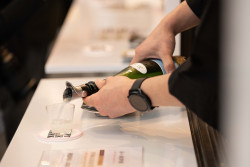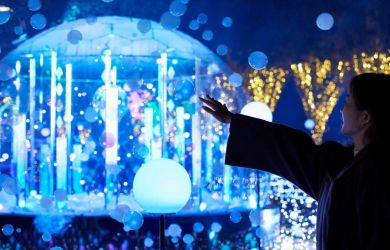
January 13, 2011
Motohiko Odani
A rising star astounds with a death-obsessed show at the Mori
By Metropolis
Originally published on metropolis.co.jp on January 2011

SP4 The Specter: What wonders around in every mind, 2009, sculpture
Photos by C.B. Liddell
Fame is a disease—or at least a symptom of a disease. Dig deep enough and you’ll find that most prominent people—I’m talking actors, rock stars, politicians and great artists—have some dark, twisted secret bottled up in the caverns of their minds that gives them the drive they need to rise above the rest of us. At least, this is what I found myself thinking at “Phantom Limb,” the solo show of Motohiko Odani at the Mori Art Museum.
If the Japanese art world has a “golden boy” at the moment, then this stylish and immensely talented 38-year-old is it. Not only has Odani already represented his country at the prestigious Venice Biennale—and a full five years ago, at that—but this show makes him the youngest artist to be given the honor of a solo exhibit at the Mori.

SP2 New Born, 2007, sculpture
This is not just an honor. It’s also a challenge, because the Mori is one of the biggest spaces an artist can be asked to fill on his own. Odani, however, rises to the challenge masterfully with a fascinating and varied show that fills each of the hangar-like rooms without ever giving the impression that he had to stretch to do it.
In addition to being young(ish), cool and trendy, Odani is also multitalented, able to express himself through a wide variety of media. This is one of the things that makes the show so enjoyable. And there is no “Jack of all trades” effect, either. Odani is able to deliver spellbinding sculpture, memorable video installations and an incredible all-round experience called “Inferno” that places you in the heart of a waterfall and convinces your mind that you’re falling into some evil dimension hidden inside the Mori Tower.
The artist has everything going for him and the world is his oyster, but this exhibition is haunted by a morose subtext that suggests a dark heart beneath the golden shine.

Hollow: Reversal Cradle, 2009, fiber-reinforced plastic
The title of the show refers to the severed limbs that amputees can nevertheless still sense. In the same way, Odani wants to give form to abstract sensations and psychological states, and by doing so allow us to sense the “invisible world” that modern life, with its visible distractions, has “amputated” from us. This is all very deep and profound, but for some reason, the artist always ends up focusing on negatives: fear, pain, unease and, most of all, death.
Such morbidity and pessimism is expressed most blatantly in the “Dying Slave” series, which includes a giant rotating wax skull—an astounding visual object, but not exactly something that the folks at the Tokyo English Life Line would like their clientele to see. According to the printed explanation, the series is “based on the concept that all people are like slaves who spend their lives marching towards death.” Imagine how Odani would have felt if he had never escaped the rat race by becoming a successful artist!
Following “Dying Slave” is a pistol made out of animal fangs, another spinning skull, and then a roomful of fascinating bone-like sculptures. Once again, there’s no denying Odani’s imagination and technical ability, but this is all a bit like writing a suicide note in beautiful calligraphy and rhyming hexameters on a gold-bordered scroll of the finest vellum.
After encountering what I took to be the Fourth Horseman of the Apocalypse—the magnificent sculpture SP4 The Specter—and a room populated with incredibly beautiful wraith-like sculptures, I found myself starting to wonder about Odani’s own “phantom limb.” What was the dark, hidden event or secret tragedy that now expressed itself so relentlessly in his art? Did he fall out of his pram? Was he bullied in school? Did he accidentally read a Samuel Beckett play at an impressionable age? Is he an ex-emo kid? Come to this exhibition and you will wonder, too.
Mori Art Museum
Motohiko Odani. Phantom Limb. Sculpture, installation. Until Feb 27, ¥500 (MS and under)/¥1,000 (HS, univ)/¥1,500 (adult). MAM Project 013: Katerina Seda. Various media. Until Feb 27, free (with Odani admission). Mori Tower Roppongi Hills, 6-10-1 Roppongi, Minato-ku. Tel: 03-5777-8600. Open Wed-Mon 10am-10pm, Tue 10am-5pm. Nearest stn: Roppongi. www.mori.art.museum/eng





